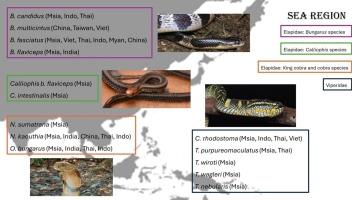用鸟枪蛋白质组学方法获得的东南亚地区马来西亚蛇的比较毒液蛋白质组学:系统综述
IF 2.2
2区 生物学
Q4 BIOCHEMISTRY & MOLECULAR BIOLOGY
Comparative Biochemistry and Physiology D-Genomics & Proteomics
Pub Date : 2025-08-27
DOI:10.1016/j.cbd.2025.101624
引用次数: 0
摘要
蛇咬伤(SBE)是包括马来西亚在内的东盟国家一个严重但被忽视的公共卫生问题。抗蛇毒血清免疫疗法是SBE的主要治疗方法,其作用是通过免疫动物产生的抗体中和有毒毒液成分。目前的抗蛇毒血清由于毒液的区域差异而可能降低疗效。本系统综述的目的是巩固和比较从马来西亚采集的马来西亚毒蛇(elapids和viperids)的毒液蛋白质组组成,与在其他东南亚(SEA)地区采集的同类毒蛇。检索2014年1月至2024年12月在ScienceDirect、PubMed和Ovid MEDLINE数据库中发表的相关英文文献。共导入630项研究进行筛查。68篇文章接受了全文评估以确定其入选资格,最终有36篇文章入选系统评价。其中,对马来西亚和东南亚其他地区9种elapids和5种viperids的蛋白质组学组成进行了整合,其中3项研究同时调查了elapids和viperids, 26项研究只调查了elapids, 7项研究只调查了viperids。结果揭示了毒液蛋白质组在种间和种内水平上的地理差异。对马来西亚毒蛇和东南亚毒蛇之间的毒液蛋白质组学进行比较分析,使种内变异和临床毒理学之间具有相关性,支持开发更有效的抗蛇毒血清(即,物种和区域特异性,以及“通用”),并为临床医生提供更合适的抗蛇毒血清提供有价值的信息。本文章由计算机程序翻译,如有差异,请以英文原文为准。

Comparative venom proteomes of Malaysian snake species from regions in Southeast Asia obtained by shotgun proteomics: A systematic review
Snakebite envenoming (SBE) is a critical yet neglected public health issue in ASEAN countries, including Malaysia. Antivenom immunotherapy is the primary treatment for SBE, functioning by neutralising toxic venom components through antibodies raised from immunised animals. Current antivenoms come with potential reduced efficacy due to regional venom variability. The aim of this systematic review is to consolidate and compare the venom proteome composition from Malaysian venomous snakes (elapids and viperids) sampled from Malaysia, with their counterparts sampled across other Southeast Asia (SEA) regions. Literature search on ScienceDirect, PubMed, and Ovid MEDLINE databases were done on relevant studies published in English from Jan 2014 to Dec 2024. A total of 630 studies were imported for screening. 68 articles received full text assessment to determine their eligibility, and finally, 36 articles were eligible for the systematic review. Among these, proteomic compositions from 9 elapid and 5 viperid species from Malaysia, and their counterparts in other SEA regions were consolidated, with 3 studies investigated both elapids and viperids, 26 studies investigated only elapid(s), and 7 studies investigated only viperid(s). Results revealed geographical variability between venom proteomes at the inter- and intra- specific level. Comparative analysis of venom proteomes between Malaysian venomous snakes and their counterparts located across SEA enables correlation between intra-species variation and clinical toxinology, supporting efforts towards the development of a more effective antivenom (i.e., species- and region-specific, as well as 'universal'), and providing valuable information for clinicians in administering a more appropriate antivenom.
求助全文
通过发布文献求助,成功后即可免费获取论文全文。
去求助
来源期刊
CiteScore
5.10
自引率
3.30%
发文量
69
审稿时长
33 days
期刊介绍:
Comparative Biochemistry & Physiology (CBP) publishes papers in comparative, environmental and evolutionary physiology.
Part D: Genomics and Proteomics (CBPD), focuses on “omics” approaches to physiology, including comparative and functional genomics, metagenomics, transcriptomics, proteomics, metabolomics, and lipidomics. Most studies employ “omics” and/or system biology to test specific hypotheses about molecular and biochemical mechanisms underlying physiological responses to the environment. We encourage papers that address fundamental questions in comparative physiology and biochemistry rather than studies with a focus that is purely technical, methodological or descriptive in nature.

 求助内容:
求助内容: 应助结果提醒方式:
应助结果提醒方式:


